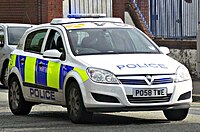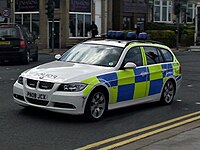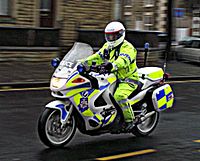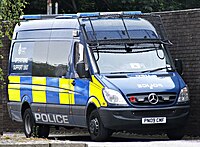Lancashire Constabulary: Difference between revisions
Megasam4256 (talk | contribs) No edit summary |
Megasam4256 (talk | contribs) →Vehicles: photos added |
||
| Line 151: | Line 151: | ||
'''Beat patrol car'''<br /> |
'''Beat patrol car'''<br /> |
||
The standard patrol car is the Hyundai i30 Estate, replacing the Vauxhall Astra.<br /> |
The standard patrol car is the Hyundai i30 Estate, replacing the Vauxhall Astra.<br /> |
||
[[File:Lancs Patrol car.jpg| |
[[File:Lancs Patrol car.jpg|200px|Astra]] |
||
<br /> |
<br /> |
||
'''Roads Policing Unit'''<br /> |
'''Roads Policing Unit'''<br /> |
||
Lancashire Constabulary uses BMW 5-Series Estates for Divisional Roads Policing (Traffic). Previously they used a fleet of BMW 3-Series Estates, and prior to that the Vauxhall Vectra.<br /> |
Lancashire Constabulary uses BMW 5-Series Estates for Divisional Roads Policing (Traffic). Previously they used a fleet of BMW 3-Series Estates, and prior to that the Vauxhall Vectra.<br /> |
||
[[File:Lancs RPU wiki.jpg|200px|BMW 5 Series]] |
|||
<br /> |
<br /> |
||
'''Motorbike'''<br /> |
'''Motorbike'''<br /> |
||
A number of motorcycles are in use by the force. These are primarily used for traffic duties and escorting.<br /> |
A number of motorcycles are in use by the force. These are primarily used for traffic duties and escorting.<br /> |
||
[[File:Lancs bike wiki.jpg|200px|BMW k1200]] |
|||
<br /> |
<br /> |
||
'''Motorway |
'''Motorway |
||
'''<br /> |
'''<br /> |
||
Motorway vehicles are a mixture of Volvo S60s and Land Rover Discoveries. The Volvo typically carries VASCAR equipment, mobile video equipment and Tracker. The Land Rovers have the same equipment as the Volvo, but a lot more equipment in the back, including a camera, tape measure, carriage marking spray, tow rope, hazard and police tape, portable blue lights, cones and a first aid kit.<br /> |
Motorway vehicles are a mixture of Volvo S60s and Land Rover Discoveries. The Volvo typically carries VASCAR equipment, mobile video equipment and Tracker. The Land Rovers have the same equipment as the Volvo, but a lot more equipment in the back, including a camera, tape measure, carriage marking spray, tow rope, hazard and police tape, portable blue lights, cones and a first aid kit.<br /> |
||
[[File:Lancs motorway unit wiki.jpg|200px|Discovey 3]] |
|||
<br /> |
<br /> |
||
'''Operations Support Unit'''<br /> |
'''Operations Support Unit'''<br /> |
||
The OSU (Operations Support Unit), known colloquially as a "riot van", is used for providing a response to public order incidents and also finds use during Operation Summer Nights and similar initiatives. It is able to carry up to 9 people. Lancashire Constabulary has 33 carriers in use across the county. It has special features including headlight grilles, which protect the headlights when missiles are thrown at the vehicle, a windscreen grille, which helps protect the vehicle's windscreen and officers when missiles are thrown at the vehicle, and run flat tyres. The vehicle has now also been fiited with safes where taser guns can ble locked and secured.<br /> |
The OSU (Operations Support Unit), known colloquially as a "riot van", is used for providing a response to public order incidents and also finds use during Operation Summer Nights and similar initiatives. It is able to carry up to 9 people. Lancashire Constabulary has 33 carriers in use across the county. It has special features including headlight grilles, which protect the headlights when missiles are thrown at the vehicle, a windscreen grille, which helps protect the vehicle's windscreen and officers when missiles are thrown at the vehicle, and run flat tyres. The vehicle has now also been fiited with safes where taser guns can ble locked and secured.<br /> |
||
[[File:Lancs POV wiki.jpg|200px|Mercedes Sprinter Van]] |
|||
<br /> |
<br /> |
||
'''Section Van'''<br /> |
'''Section Van'''<br /> |
||
| Line 175: | Line 179: | ||
<br /> |
<br /> |
||
'''Dog van'''<br /> |
'''Dog van'''<br /> |
||
There are 36 dog vehicles that are used across the force. The big vans can carry up to four dogs and the smaller cars can carry up to 2 dogs. The vehicles have been specially modified for the dogs and the roofs of the vehicles have special vents so that the dogs are well looked after. |
There are 36 dog vehicles that are used across the force. The big vans can carry up to four dogs and the smaller cars can carry up to 2 dogs. The vehicles have been specially modified for the dogs and the roofs of the vehicles have special vents so that the dogs are well looked after.<br /> |
||
[[File:Lancs Dog Section - wiki.jpg|200px|Add caption here]] |
|||
== Air Support Unit == |
== Air Support Unit == |
||
Revision as of 14:43, 3 September 2012
| Lancashire Constabulary | |
|---|---|
| File:Lancashireconstabulary.png | |
| Agency overview | |
| Formed | 1839 |
| Jurisdictional structure | |
| Operations jurisdiction | Lancashire, UK |
 | |
| Map of Lancashire Constabulary's jurisdiction | |
| Size | 2,903 |
| Population | 1,500,000 |
| Operational structure | |
| Headquarters | Hutton, near Preston |
| Sworn members | 3,554 |
| Agency executive |
|
| Divisions | 8 |
| Facilities | |
| Stations | 36 |
| Website | |
| www.lancashire.police.uk | |
Lancashire Constabulary is the territorial police force responsible for policing the ceremonial county of Lancashire in the North West England. The force's headquarters are at Hutton, near the city of Preston. The force has over 3,000 officers as well as 500 Police Community Support Officers.
History
After many complaints over a number of years over the crime ridden state of Lancashire it was decided in 1839 that a combined county police force was required to police the county. In the same year the force was founded and Captain John Woodford was made Chief Constable with 2 Assistant Chief Constables, 14 Superintendents and 660 Constables.
Over the next 50 years the Police force saw many changes including the introduction of the Police Helmet and, during the 1860s, the force lost its first officer, PC Jump, who died after being shot by a group of men that he and a colleague were searching. By the end of the century the force had developed a detective department who were allowed to wear plain clothes. The first detective appointed was John Wallbank.
In 1917 the force first allowed female officers although it was only up until the 1950s when they were allowed uniforms and not until the 1970s were they paid at the same rate as their male counterparts. In 1948 the force's dog section was established with many differing breeds being used but by the 1950s it was established that the German Shepherd was the most suitable.
In 1965, the force had an establishment of 3,784 officers and an actual strength of 3,454, making it the second largest police force (after the Metropolitan Police) and the largest county force in Great Britain.[1]
The force then went through major changes in the 1970s when the force was reduced to cover the new re-bordered Lancashire with the other areas coming under the jurisdiction of Greater Manchester Police and Merseyside Police.
On 10 October 2007 the Home Office announced that Lancashire Constabulary had ranked joint first, with Surrey, out of 43 forces by Her Majesty's Inspectorate of Constabularies. All 43 Police forces were assessed on seven areas - tackling crime, serious crime, protecting vulnerable people, satisfaction, neighbourhood policing, local priorities and resources and efficiency.
The Radio Branch or Wireless Workshops pioneered many techniques in the use of radio by the police. In 1925 they had radio communications between Constabulary headquarters in Preston and six divisional headquarters. A year later a van was equipped with a transmitter. Tests were done with radio communication to cars in the 1930s. In 1939 four fixed stations provided coverage over much of the county. At the start of World War II divisional headquarters were equipped with transmitter-receivers as a back-up to the telephone system. This was used in 1941 when the telephone system in Liverpool was put out of action by bombing, Lancashire Constabulary's radio system was sole means of communications with the city for a time. After the war they were involved in the development and move to VHF FM by the UK police. In 1961 a personal radio scheme was installed in Chorley with Motorola VHF personal radios imported from the USA after a demonstration in Stretford in 1959. This led in 1963 to the design of the Lancon[2] VHF personal radio manufactured by GEC.[3]
Divisions
The force is split into eight divisions, six geographical and two based at the Force HQ at Hutton. However, the split is approximate, and divisions are deliberately vague, giving a seamless approach to policing in the Lancashire area. The geographical divisions and their headquarters are as follows:
- Western (A Division)
- The headquarters are in Blackpool from where this division is responsible for the Fylde area stretching from Bispham down to Kirkham.
- Northern (B Division)
- The headquarters are in Lancaster it is also assigned with the policing of Morecambe, Heysham and the Wyre area.
- Southern (C Division)
- The headquarters are in Leyland from where this division polices the South Ribble, Chorley and West Lancashire areas.
- Central (D Division)
- This division is primarily assigned to police the City of Preston.
- Eastern (E Division)
- Primarily assigned to Police the Blackburn with Darwen, Ribble Valley and Accrington areas.
- Pennine (F Division)
- Assigned to Police the Burnley, Pendle and Rossendale areas.
- G Division
- Headquarters; encompassing the Force Intelligence Department (F.I.D), Serious Organised Crime Unit (S.O.C.U) & Special Branch (S.B).
- H Division
- Operations Support and Operations Planning. Encompasses Motorway, Armed Response, Air Support, Mounted and various other functions.
Police Stations
The constabulary has 36 full-time stations across the county with over 100 further police posts and smaller village stations. Although the county has this large number of stations less than half have adequate provisions to hold prisoners. The training of student officers is undertaken at five sites, HQ (Hutton), Rawtenstall, Fleetwood, Skelmersdale and Morecambe. In addition, specialist training and certain sections such as the dog and mounted are based at the Force's HQ at Hutton.
Equipment
The routine patrol officer is not armed but does carry a baton (either an ASP or a Monadnock MX21, chosen by the officer), a PAVA incapacitant spray, limb restraints (leg restraints), a first aid kit, a torch and rigid handcuffs. All police officers, special constables, PCSOs and civilian members of staff are required to wear a stab vest when on duty and "not in an office environment"; most choose to wear their vest at all times. Lancashire Constabulary issues high visibility stab vests made by German manufacturer "Mehler Vario Systems". Black body armour covers are issued to officers engaged in covert operations, in un-marked vehicles and to "Support Unit" officers. Although officers are not routinely armed, many response and neighbourhood policing officers are now trained in the use of Taser guns and routinely carry them whilst on patrol. Lancashire also has several Armed Response Teams carrying G36 assault rifles, Glock pistols and Taser guns.
Vehicles
Beat patrol car
The standard patrol car is the Hyundai i30 Estate, replacing the Vauxhall Astra.

Roads Policing Unit
Lancashire Constabulary uses BMW 5-Series Estates for Divisional Roads Policing (Traffic). Previously they used a fleet of BMW 3-Series Estates, and prior to that the Vauxhall Vectra.

Motorbike
A number of motorcycles are in use by the force. These are primarily used for traffic duties and escorting.

Motorway
Motorway vehicles are a mixture of Volvo S60s and Land Rover Discoveries. The Volvo typically carries VASCAR equipment, mobile video equipment and Tracker. The Land Rovers have the same equipment as the Volvo, but a lot more equipment in the back, including a camera, tape measure, carriage marking spray, tow rope, hazard and police tape, portable blue lights, cones and a first aid kit.

Operations Support Unit
The OSU (Operations Support Unit), known colloquially as a "riot van", is used for providing a response to public order incidents and also finds use during Operation Summer Nights and similar initiatives. It is able to carry up to 9 people. Lancashire Constabulary has 33 carriers in use across the county. It has special features including headlight grilles, which protect the headlights when missiles are thrown at the vehicle, a windscreen grille, which helps protect the vehicle's windscreen and officers when missiles are thrown at the vehicle, and run flat tyres. The vehicle has now also been fiited with safes where taser guns can ble locked and secured.

Section Van
The section van is used to transport suspects to the police station. There are 66 operational section vans in use across the county.
Armed Response Vehicle (ARV)
Lancashire Constabulary currently has 6 Armed Response Vehicles, which are based within the 6 Divisions in Lancashire. The Armed Response vehicles were, up until recently, Ford Galaxies but they are now being replaced by the Ford S-Max. They’re crewed by two authorised firearms officers and have a safe, which holds firearms equipment.
Dog van
There are 36 dog vehicles that are used across the force. The big vans can carry up to four dogs and the smaller cars can carry up to 2 dogs. The vehicles have been specially modified for the dogs and the roofs of the vehicles have special vents so that the dogs are well looked after.

Air Support Unit
The force also operates an EC135 helicopter based at BAE Warton, the Helicopter is available to reach any part of Lancashire within 15 minutes. The force has had an ASU since 1994 when it fielded a Eurocopter Squirrel but this was retired in the early 2000s as it was replaced by the newer EC 135. The ASU is primarily there to assist ground forces as well as provide evidence and surveillance where needed.
Motorway Unit
The Force's motorway policing unit has headquarters at Samlesbury near Preston. The unit is led by a single Inspector who in turn is responsible for 7 Sergeants and 43 Police Constables. The unit also operates a vehicle checking station at Cuerden between Chorley and Preston on the M65, this is done in co-operation with VOSA.
Lancashire's motorway unit is one of the four forces that make up the North West Motorway Police Group (along with Merseyside Police, Greater Manchester Police and Cheshire Constabulary)
Firearms Unit
Due to police officers in the county not being routinely armed the force has its own specialised firearms unit based at locations around the county. The force has at any one time has 9 armed officers on patrol. The standard issue weapon is the Glock SLP whilst officers are also armed with the Heckler & Koch G36 Carbine. Tasers are carried by Armed Response Officers as well as officers from the Operations Support Unit and appropriately trained local officers.
Collaborations
Lancashire Constabulary is a partner in the following collaborations:
Proposed merger
Under proposals made by the Home Secretary on 6 February 2006, it was to have be merged with Cumbria Constabulary. These were accepted by both forces on 26 February, and the merger would have taken place on 1 April 2007.[1]. However, in July 2006, both Cumbria and Lancashire Constabularies decided not to proceed with the merger because the government failed to remedy issues with the council tax precept which left both forces unable to proceed.
Intelligence Analysis
Over recent years, Lancashire Constabulary has developed a reputation for leading the way in Intelligence Analysis and holds an annual Intelligence Analysis conference in Blackpool attended by a large number of analysts from other UK police forces and law enforcement agencies. Other forces are now looking to Lancashire as a pioneering force in IT support. In particular in 2007 Cumbria Police (and more recently Durham Constabulary) secured their own version of Lancashire's Intelligence, Police investigation and work management system SLEUTH; an easy to use front line focussed alternative to NICHE Record Management System.
Officers killed in the line of duty
The Police Memorial Trust lists and commemorates all British police officers killed in the line of duty, and since its establishment in 1984 has erected over 38 memorials to some of those officers.
The following officers of Lancashire Constabulary are listed by the Trust as having died attempting to prevent, stop or solve a crime, since the turn of the 20th century:[4]
- PC Peter Burnett, 1990 (collapsed and died attempting to disperse rioters)
- PC Ian Wain Woodward, 1987 (shot dead)
- Acting Sgt Walter Lacey, 1978 (collapsed and died attempting to arrest a suspect)
- Supt Gerry Richardson GC, 1971 (shot dead attempting to arrest a gunman who had shot a fellow officer; posthumously awarded the George Cross)
- PC Ernest Southern, 1962 (collapsed and died attending a street affray)
- DI James O'Donnell QPM, 1958 (shot dead attempting to arrest a gunman who had shot two others; posthumously awarded the Queen's Police Medal)
- PC Sydney Arthur Tysoe, 1949 (died from injuries sustained during an arrest in 1940)
- War Reserve Constable John Towers, 1943 (died from injuries sustained in an assault)
- PC Stewart Mungo Whillis, 1907 (died from injuries sustained in an assault in 1901)
Footnotes
- ^ The Thin Blue Line, Police Council for Great Britain Staff Side Claim for Undermanning Supplements, 1965
- ^ GEC Lancon personal radio
- ^ Mobile radio for Lancashire's police, J. Davies, Electronics & Wireless World
- ^ http://www.policememorial.org.uk/Police_Memorial_Trust/NPM_Roll_GREAT_BRITAIN%20by%20Area.htm
See also
- Policing in the United Kingdom
- GRIP (Group Intervention Panel)
- Operation Tremor
- Operation Summer Nights
- Road Policing Unit
- Lancashire Fire and Rescue Service
- Lancashire Probation Trust
